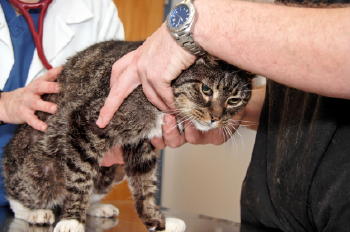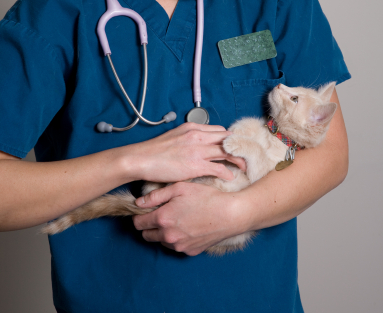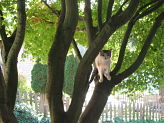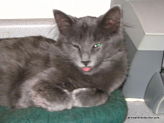Cat Heart Disease

Cat heart disease or feline cardiomyopathy...heart problems in cats are not as common as in humans but they still can have them. The most common problem in cats is heart-muscle disease...cardiomyopathy and this causes a lot of trouble. As the heart disease progresses, the heart can't pump effectively, and blood backs up...congestive heart failure. Pressure then builds up in the vessels leading to the heart causing fluid to leak out into the lungs...pulmonary edema and chest cavity...pleural effusion.
In about 30% of cats with cardiomyopathy, poor blood flow through the heart encourages the formation of a blood clot...thrombus. If the clot leaves the heart, it often lodges in a blood vessel of a limb, an internal organ, or the brain...causing pain, paralysis, seizures, or even death. A saddle thrombus which obstructs the two hind leg arteries and usually paralyzes the legs...occurs more frequently than any other type of clot.
Some heart muscle problems develop as the result of a treatable condition such as feline hyperthyroidism which is an overactive thyroid gland. Another cause is hypertension which is high blood pressure, or a deficiency of the amino acid taurine in the diet. However, most cases of cardiomyopathy stem from unknown causes referred to as idiopathic. Veterinarians can't cure idiopathic cardiomyopathy, but, with early diagnosis, they may be able to keep the cat heart disease under control.
A taurine deficiency can be a cause of dilated cardiomyopathy (DCM) and was the primary cause of DCM prior to the pet food companies fortifying commercial cat foods with this amino-sulfonic acid. This deficiency is mainly found in cats eating vegetarian diets or cats forced to consume low-protein dog food.
Taurine, which is found in ample amounts in fish, animal tissue, and feline milk, is almost completely absent in cereals or vegetable matter. Cats have an especially high requirement for a dietary source of this nutrient. Unlike some species, cats cannot synthesize in their intestinal tracts sufficient quantities of taurine from other components of their diet.
The specific role that taurine plays in the health of the heart is complex; in essence, this nutrient stabilizes heart tissue membranes. When taurine is absent or deficient in the diet, the muscular walls of the heart become thinner and expand like the sides of a balloon. Eventually, the distended walls contribute to less efficient opening and closing of heart valves, leading to one or more heart murmurs. Fluid leaks into the chest cavity, causing congestion and difficulty breathing...cat heart disease.
There are some cases of cat heart disease, specifically DCM, where dietary taurine deficiency is not the cause...so the cat heart disease is called idiopathic (which means the cause is unknown). Scientists believe that a genetic component regulates a cat's ability to absorb and metabolize taurine. Siamese, Abyssinian and Burmese have an increased incidence of DCM. In some cats, increased excretion of taurine might account for the metabolic deficiency.
Unfortunately, cardiomyopathy is hard to spot. When the cat heart disease has reached the point of congestive heart failure the cat will start showing signs of lethargy, failing to eat, breathing difficulties and an increased heart rate... tachycardia. Your veterinarian may notice a problem earlier by listening to your cat's heart through a stethoscope during an annual exam.
Ailing hearts often make an abnormal sound such as a murmur which indicates turbulent blood flow or a gallop rhythm that occurs when blood flows into abnormal heart chambers...alerting your vet about cat heart disease.
If your vet hears an abnormal sound it doesn't necessarily mean your cat has heart disease, but you should consider additional tests like x-rays or other options suggested by your vet. Most cases of heart muscle disease are either hypertrophic cardiomyopathy or dilated cardiomyopathy. A few cats develop intermediate cardiomyopathies with characteristics that don't fit into either of the categories.
One of these is restrictive cardiomyopathy (RCM). RCM is characterized by hardening of the heart muscle which causes dysfunction of both the filling and pumping of the heart. Therefore, this cat heart disease is known as intergrade or intermediate cardiomyopathy. Clinical signs of RCM vary from those associated with congestive heart failure and/or arterial thromboembolism to none.
It is less common than DCM and HCM. In hypertrophic cardiomyopathy, the heart muscle thickens and stiffens so the heart's chambers are greatly reduced in volume and can't relax properly after contracting. In dilated cardiomyopathy, the heart's chambers expand so the heart is enlarged and the muscle is flabby.
Hypertrophic cardiomyopathy HCM) is the most frequently diagnosed cat heart disease. HCM is characterized by thickening of the left ventricle or of the wall dividing the two ventricles or lower chambers of the heart. As the heart muscle thickens, it becomes stiff and less distensible, allowing incomplete filling of the left ventricle during relaxation of the heart muscle.
In some cases, the left atrium enlarges, giving a valentine appearance to the heart. Because HCM creates blood flow abnormalities and alters normal blood coagulation, blood clots may form within the heart and arteries.
Two major syndromes associated with HCM are congestive heart failure and arterial thromboembolism (blood clots in the arteries). The signs of congestive heart failure may at first be subtle...reduced appetite, lethargy, and labored breathing worsened by exercise.
When the veterinarian examines a cat suffering from HCM with his stethoscope, he can usually detect chest congestion, heart murmers and/or extra heart sound, and irregularities in the heart rhythm. The cat often shows cyanosis (bluish skin) caused by reduced oxygen levels, most noticeable as pale membranes of the eyes or skin of inner ear flaps. His abdomen may be distended from fluid accumulation.
The signs of the second syndrome...arterial thromboembolism...may appear alone or simultaneously with signs of congestive heart failure. This form of circulatory problem is seen in patients with any form of cardiomyopathy, but is found most often in those suffering from HCM. Ninety percent of the time, the blood clot obstructs the distal aorta where the vessel branches to supply blood to the hind limbs.
When blood to the rear legs is cut off, the cat cannot walk; she can flex and extend her hips but drags her lower legs. When the vet feels at the base of the cat's inner thigh for evidence that blood is flowing through the artery, he finds no pulse; the limbs are painful and cool to touch; and the nail beds show a bluish-tinge caused by lack of blood-carrying oxygen.
The causation of primary HCM in most cats is unknown although felines with Maine coon breeding are more often affected than those of other breeds. Clinical signs of HCM are seen secondarily in cats with hyperthyroidism, high blood pressure associated with kidney disease, increased growth hormone secretion; and birth disorders.
Numerous studies in the veterinary literature show that a large percentage of cats more than 12 years of age have hypertension, either secondary to chronic renal disease or from underlying thyroid disease.
Not all cardiomyopathies are the same so vets tailor treatment according to each case. For cats with hypertrophic cardiomyopathy, drugs like diltiazem, propranolol, and atenolol can help reduce heart rate and relax the thickened heart muscle. In cases of dilated cardiomyopathy the treatment is usually taurine supplementation and the drug digoxin which strengthens muscle contraction of the weak heart chambers.
Both types of cardiomyopathy may lead to congestive heart failure, for which vets often prescribe low salt diets and diuretics such as furosemide (Lasix) to reduce fluid accumulation. Vasodilators such as enalapril may be used as well to reduce blood pressure. Lower priced drugs are available with online reputable companies. Simply click on "Cat Medications".
Related Articles......
Return from Cat Heart Disease to Cat Health Homepage
Having trouble finding what you need? Cat Health Index & Site Map
OR
Do you have a question to ask?...Questions
OR
Do you have a cat story to share?...Simply click here to go to that page!
Copyright@2010-2020 All rights reserved.Cat-health-detective.com
This website is information only. Consult a veterinarian for medical assistance

"Like Us" on Facebook
or...
"Like Us" here




















